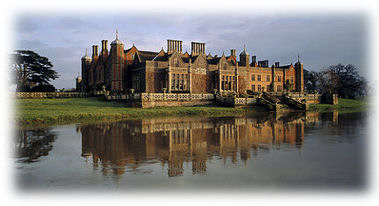William Lucy, Fourth son of Sir Thomas Lucy 2nd. Lucy,
William (15941677), bishop of St David's, was born at Hurstbourne,
Hampshire, the fourth son of Sir Thomas Lucy (15511605) of Charlecote,
Warwickshire, and his second wife, Constance, daughter and heir of
Richard Kingsmill (c. 15281600) of Highclere, Hampshire; Sir Thomas
Lucy (15831640) and Sir Richard Lucy (15921667) were his elder brothers.
In
1610 William Lucy was admitted to Trinity College, Oxford, where he
graduated BA on 18 November 1613. He was admitted to Lincoln's Inn
on 25 May 1614 but 'upon second thoughts, and perhaps a desire of
a sedate and academical life' (Wood, Ath. Oxon., 3.1127) he entered
Gonville and Caius College as a fellow-commoner on 12 June 1615. He
proceeded MA the following year and was ordained deacon at London
on 21 December 1617. In 1619 Lucy became rector of Burghclere, Hampshire.
Several years later he was appointed chaplain to the duke of Buckingham,
on the recommendation of James I. Appointed
as a university preacher at Cambridge in 1620 Lucy gained notoriety
for delivering on commencement Sunday 1622, before the largely Calvinist
university, an anti-Calvinist sermon which Joseph Meade described
as being 'totally for Arminanisme, wonderfully bold and peremptorily,
styling some passages to the contrary by names of blasphemie etc.'
(BL, Harley MS 389, fol. 213). The scandal over the sermon led to
calls for Lucy to be denied higher degrees, but he escaped censure
with the support of the King against what appears to have been heavy
opposition. Three years later he was appointed rector of Highclere,
Hampshire. Highclere at that time was was owned by his older brother,
Thomas Lucy 111. On 12 February 1629 at St Bride's, Fleet Street,
London, Lucy married Martha (16081674), daughter of William Angel.
They had two daughters and five sons, including Spencer Lucy (1643/41691).??Lucy
lived at Burghclere until the outbreak of the civil war, when, as
a staunch royalist, he was 'both active and passive to his ability
in the great cause' (Bodl. Oxf., MS Tanner 146, fol. 133). His house
was searched and his extensive library seized. An informer suggested
that he was raising money for the duke of York. In April 1651 the
committee for compounding ordered his estates in Hampshire to be seized.
After
being sent a copy of Thomas Hobbes's Leviathan (1651), and noting
its popularity with local gentlemen, Lucy composed Examinations, Censures
and Confutations of Divers Errours of Mr Hobbes Leviathan (1657),
published under the pseudonym William Pike (a play on his name). In
addition to his work against Hobbes, Lucy also composed in the 1650s
A Treatise of the Nature of a Minister, a defence of episcopal authority
in the apostolic church against the New England congregationalist
Thomas Hooker's A Survey of the Summe of Church-Discipline (1648).
Lucy eventually published his book in 1670. One
wonders whether these publications are in the library at Charlecote.??At
the Restoration, Lucy's loyalty was rewarded when, on 11 October 1660,
he was elected bishop of St David's, his confirmation and consecration
taking place on 17 and 18 November 1660. Lucy faced a difficult task
at St David's. Episcopal administration of the diocese, one of the
largest and poorest in Britain, had effectively ceased in 1640. The
cathedral at St David's, the collegiate church at Brecon, and the
bishop's houses at Brecon and Abergwili were practically in ruins,
the decay exacerbated by plundering during the interregnum. Lucy's
effectiveness as an administrator is a subject of some debate. He
was posthumously charged with having 'lived in a woeful and culpable
omission of many of the direct and important as well sacred as other
duties of his office' (Ferguson, 212). He is said to have neglected
to hold confirmations in his diocese and to have connived at the exaction
of exorbitant fees, as well as filling the cathedral with non-residents
and preferring royalists and his own family exclusively to benefices
in the diocese. Some of these charges were justified: his son Spencer,
for instance, became in 1669 vicar of Penbryn, Cardiganshire, and
canon and treasurer of St David's. However, Lucy's transgressions
went hand in hand with his attempts to combat religious dissent and
revive the fortunes of the church in his diocese. He does appear to
have made considerable efforts to improve the condition of the diocese.
Large sums were spent in the restoration of the collegiate church
and the bishop's and prebendary's houses at Brecon as well as sums
in augmentation of poor vicarages. Bishop Thomas Burgess, Lucy's nineteenth-century
successor and champion, considered that Lucy could be considered 'the
second founder of the College at Brecknock' (Burgess, 256). There
is a memorial to him in St. Davids Cathedral paid for and dedicated
by his descendant John Lucy, Vicar of Hampton Lucy in the nineteenth
century and installed as part of the restoration of the cathedral
by George Gilbert Scott. The
dedication on the brass plaque below the lancets reads as follows:-??IN
HONOREM DEI, ET IN MEMORIAM GULIELMI LUCY, STP HUIUS ECCLESIA CATHEDRALIS
REGNANTE CAROLO SECUNDO PRAECLARI EPISCOPI, HAS PICTORAS MURALES ET
FENESTRAS SUPERNE POSITAS, PIETATE ADDUCTOS, DUT DEDICAT JOHANNES
LUCY PER MULTOS ANNOS HAMPTON LUCY RECTOR, AD MDCCCLXXI.? Which
roughly translates to: IN
HONOUR OF GOD, AND IN MEMORY OF WILLIAM LUCY GREAT BISHOP OF THIS
CATHEDRAL IN THE REIGN OF CHARLES 11, THESE PAINTED MURALS AND WINDOW
ABOVE DEDICATED BY JOHN LUCY FOR MANY YEARS RECTOR OF HAMPTON LUCY,
1871. The
Rev. John Lucy (1790 - 1874) was, the brother of George Hammond Lucy
(1789 - 1845). The Rev. John Lucy was also the Rector of Hampton Lucy
between 1815 and 1874; he also had the church of St. Peter Ad Vincula
built in Hampton Lucy in 1826 and the iron bridge built over the river
Avon in 1829. A Portrait of the Rev. John Lucy hangs in the library.
Kevin
Coleman - Volunteer Guide.
Return to Index page |

